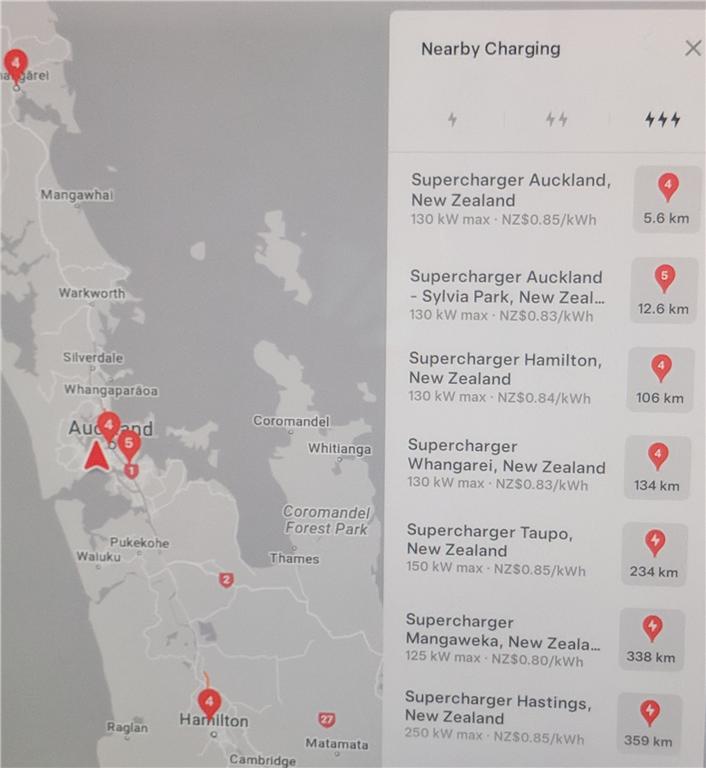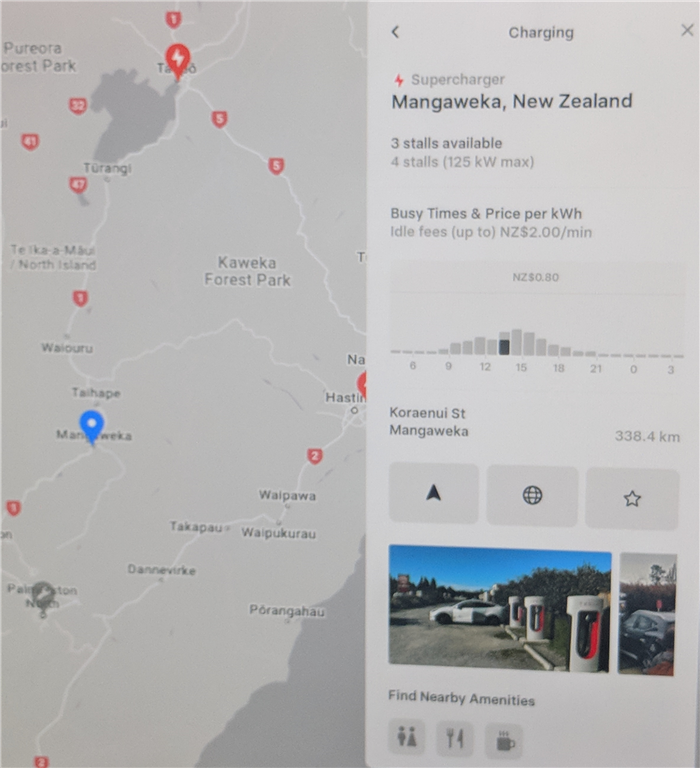The Truth
Range Updated
The quoted range is not a lie, but very hard to achieve as they are derived by measurement and calculations when stationary. There are many variables affecting range, but after many years driving ICE vehicles some are never considered important. Because of their poor efficiency, cabin heating is never an issue, as wasted heat energy is plentiful and has no effect on economy or ICE range. (One could argue it improves efficiency as the heat now has a use.)
Not so with an E.V. where energy for everything must come from its battery and therefore must affect range. Even Wipers, Lights, Electronics, Seat heaters, Cameras and entertainment systems all take their toll on actual EV range.
Early Tesla's only had air conditioning, the same as ICE cars, but were heated using resistors similar to a $30 fan heater from your local hardware. Many newer E. V's have heat-pumps, which greatly helps efficiency using about 1/3rd of the power. Tesla have since designed one of the most efficient ever, as it recovers heat from 16 sources, with only one being the outside air and only uses 1/5th of the equivalent resistive power. In an EV, heated seats and steering wheel are not a luxury, as, like an electric blanket, they use only 15-60 watts depending on setting. And even when compared to the heat pump, at around 1.5 kW, or resistive heating at 3-7 kW, seats are still most efficient heating option available.
On a trip from Auckland to Whanganui (445km) the Tesla computer calculated that with a 100% charge about 3% would remain on arrival. In practice, constant rain to Hamilton meant pushing about 5-10mm of water away at speed for over an hour. Every driver has felt the considerable slowing effect of suddenly hitting water at speed. This, plus the wipers, increased power usage by about 10% the car warned that a charge stop at Te Kuiti was required, as the battery would be at -5% by Whanganui. I stopped at National Park to grab some refreshments and used a fast charger, (50Kw) for 30 minutes for about $25, to arrive at Whanganui with 25% remaining.
It is normal for Lithium battery capacity to decrease with age. Generally, a range loss of about 1-2% happens quite quickly from new. This levels off and many Teslas have less than 10% loss after 200,000 Km. The battery is guaranteed for 8 years or about 200,000 Km when it must still have at least 70% of initial capacity. In practice some S Models in USA are running on their original battery at over 400,000 Km. Most NZ owners are very unlikely to ever drive one car this far. By then an ICE car would probably be on its second or a reconditioned engine. (And probably spent over $20,000 on servicing.)
While a new battery is currently not cheap, about $20,000? prices per kWh have dropped from $800 to close to $100 over about five years. If this rate continues, in 10 years a replacement if needed, might be in the order of $2000. And who knows what new technology could be available by then. A fusion reactor as in "Back to the Future"? Take your cell phone for example - when introduced basic models cost thousands, but $50 will now buy one from your local supermarket. Wrights Law in Action!
After 5 years driving my Model 3 performance, I'm still getting much the same range. Originally quoted at 310 miles (498 km) or 488 after initial 2% loss, my practical range (after some 44,000 km) is on average 440 km. After this distance there is roughly 5% remaining, (about 25 km) giving a max range of about 465 km.
This is 6% less than Tesla originally quoted, but this includes a simulated reserve tank, where independent testers drive until the car actually stops and indicate a minus percent used. I have never tried to test this, unlike my tests on most ICE cars I have owned, where, with a spare tin of gas in the boot, I always tried driving until they stopped. This test was never to determine range, but to calibrate the fuel gauge for empty and determine how far one could go below the E point or the warning light. i.e. the amount on reserve or when one needs to visit the nearest petrol station.
As a Tesla provides a list of charging places and warns when to charge on route (if feature enabled) it's impossible to unintentionally become stranded. The only time I've come slightly close is on the way home to get the cheapest charging . My typical approach is to switch the display from % to Km when I get to about 20% charge. It's then pretty easy to decide to look for a charger or continue to one's destination.
Its important to remember that road conditions, temperature, and right foot use have more influence on range than in an ICE car. Probably a safe starting point from a full charge is to plan for a range about 20% less than the manufactures quoted figure, or when below 10% state-of-charge. (SOC) In my experience I still need to stop about every 3 hours. Depending on the charger capability, to get to about 60%, can vary from 15 to 30 minutes, and is similar to an ICE vehicle when time for restroom, refreshments, filling, paying and re-parking are included. Generally the lower the SOC that charging starts from, the faster it will be. The best min and max points to aim for will of course vary between EV brands and trialing to determine.
American long distance EV drivers have consistently proved that repeatedly charging to less than 60% gives the fastest overall trip time and to only charge for the time required for rest and/or refreshment, and not to reach a specific SOC. In other words, ignore SOC and just plugin whenever one needs to stop, however short.
Charging
A lithium battery is damaged by excessive heat produced from fast charging and also a full discharge. Tesla has gone to the extreme in minimizing this with liquid cooling and cell monitoring. On the few times I have supercharged, the heat being vented on returning is considerable, and the 25mm thick charge cable quite hot. So its better, and also cheaper to slow charge when possible, at home or at destination over night,. A very important point to understand is that while charging time is inversely proportional to the power applied, the actual power applied over time is not constant and is controlled by the car software communicating with the charger, which gradually reduces the charge rate to protect the battery. (Not so for early Nissan Leafs.)
A near flat cold battery cannot accept a very high rate either and may need preheating. A Tesla will do this automatically if necessary while navigating the driver to the nearest supercharger. To avoid this, supercharge at the end of the journey while still warm, rather than when starting out on a cold morning. After first plugging in, its quite normal for the charge rate to increase over a few minutes to the maximum permitted by the car, or to that available from the charger. Once the charge reaches around 50%, (varies with battery type and model) the rate will decrease. Many fast chargers are deliberately limited to 80%, as the remaining 20% may take longer than the time taken to reach 80%. (This can inflict a range issue if away from home and no slow over-night top-up is available.)
Running the charge down to 0% is not good for the battery either and with a Tesla some features are turned off when below 20%. Tesla recommend daily usage between 20 and 80% for NMC batteries, and 100% for LFP which have a life span several times that of NMC, but a lower storage density.
(NMC = Nickle, Manganese, Cobalt. LFP = Lithium, Iron, Phosphate.)
However, with LFP always being fully topped up, the additional 20% tends to make up for its lower capacity. Its also more likely they will outlast the car itself.
Driving on long trips does need some planing in choosing charger stops with good facilities. In N.Z. a Tesla can easily travel Auckland to Wellington in a day with just one 30 minute supercharger stop. In practice, such long trips usually involve about three stops, for personal comfort and a meal. The time taken to fill-up an ICE, pay, use conveniences, wait for coffee, is close to 20 minutes. An E.V is much the same, but is left charging for the whole time. The plug-in, swipe on, and unplug times are no more than that for inserting a petrol pump hose, but excludes: holding it while filling, paying, and moving to a park, before even considering refreshments. An E.V owner proceeds straight to coffee and lunch while charging.
The main difference is one of short duration top-ups for a reduced % range rather than a complete fill-up. Also, don't forget the regular time savings of only seconds to plug in at home each day, versus the time spent at a gas station filling an ICE each and every week.
On my trip to Whanganui, due to my wrong navigation computer options, the car recommended a detour to the nearest supercharger, which happened to be in Taupo and would add an extra 160km to the trip. Unfortunately the Tesla software at the time did not know about the many independent fast chargers available in N.Z. It does see many destination chargers though. This is why in NZ one must have accounts with other power vendors. In my case I chose Charge Net who have three hundred odd of them throughout the North and South Islands. Their phone app shows:- where chargers are, if working, or currently in use. Chargers are activated with an RF ID tag or login via the app. Tesla superchargers just need plugging in as they know your car ID and already have your credit card details. However, if you don't regularly use paid chargers, remember to check your card details with each vendor before a long trip, or you may, when miles from home like me, find the charger won't work as your card has expired.
For the record, chargers are basically grouped into three types: Home or destination AC charging up to 20KW, but typically 2-10Kw. Fast DC chargers range 25-50Kw but typically give 35-45Kw. Newer ones may be rated up to 300Kw, but these typically only give 150Kw although may support two cars at once. Finally superchargers - these are Tesla branded and rated from 150Kw to 350Kw. Fast chargers generally take 30+ minutes for a useful amount and superchargers about 15 minutes. Although one should never ignore an hour of free 8Kw charging (about 10%) while shopping at your local mall.
Finding a Super Charger
Tesla N.Z superchargers are gradually being made available to other EV brands so watch out for this. In the USA, GM, Ford, and others have made deals for access and there is no reason this won't happen here. Meanwhile there are phone apps from Charge Net, Vector, Waikato (OpenLoop), PlugShare, and others available to all EV owners. Individual EV brands may eventually be able to offer direct access from their own built-in management systems.
For Tesla owners its just a screen tap on a map button to get a list with the nearest at the top. A tap on the map charger number, or an icon in list, of your choice, brings up all the information about its features, state, the directions to, and includes other site facilities with the ability to phone them, access their web site, all with a screen tab. Recently other independent charger sites are now begin included.


Many shopping malls in Auckland do provide free 8 kW destination chargers while shopping. One hour will typically add about 10% charge and for me the rest is done at home. A local 30 Km return trip takes about 30 minutes of charging at home, and with mall shopping 5Km away I usually return with more than when I left. Vector had a few free 50Kw fast chargers available in the Auckland area, which are now owned by charge-net and not free. Some other power companies offer free charging in their area. Find out with their app. The Plug-Share app covers them all and often includes useful user added hints and comments.
Running Costs
My Model 3 averages about 120-150 watts per Km while city driving, so a 20 Km trip needs 3 kWh (3 Units) to recover, and on an 8 KW wall charger this takes 20 minutes for a total cost of 57 cents. (I pay 19 cents for night-rate). Paid fast chargers (50 kW) cost up to 65 cents per kWh and this often includes a parking fee. Superchargers are about 68 cents and charge at 150 kW and therefore much quicker. Price varies depending on time of day.
Tip: Consider fitting a smart wall charger at home that you can control its on/off times and then enable it just for the 1 hour of free power, if available. If you don't drive every day, over time the car will eventually reach the % charge level set in the car for free!
The Tesla app provides a record of charging, and when configured with your power rates will calculate total costs per month and year. For my current year, as at May 2023, my charging history works out at:- 50% at home, 3% on supercharging, 0% at work and 47% other. (I work from home.) Based on this, the actual costs are: Home $124, Supercharging $28, and other $105, for yearly total of $257. The other cost is all due to Charge Net. Total power used that year was 1,412 kWh for an average cost of 18.2 cents per kW. Total distance for the year is around 10,000 Km.
Update Sept 2025 - my car is now 6 years old and calculated consumption was 1,216 kWh over the last 12 months for a total cost of $246. 71% of this was at home, 27% at free mall chargers and 2% supercharging. Actual fuel cost for the year is $180, as mail rates are calculated at the same as the home night rate. However, a hidden cost of these 'free' charges is the coffee and sandwich or movies watched while charging! The Tesla app unfortunately doesn't show the distance covered, which is approximately about 8000 Km. In future, tracking RUC will document the distance better. Over the six years to date, total Tesla costs including repairs and servicing is a little under $2000. RUC Costs so far are about $700 which over time will affect calculations.
For an ICE car, traveling that distance at 10L per 100Km would use 1000 liters of petrol, and at $3 litre cost $2400 or over 10 times that of the Tesla. This excludes a yearly ICE service of about $600. So over the 6 years of E.V ownership the ICE cost is near $18,000. Giving an approximate saving of $15,300 although repairs to the ICE are likely much greater but not known for these calculations.
When first considering a new car, our alternative was a Lexus IS 300 that cost about the same as a long range Tesla. While I paid extra for the performance model, that cost difference has now been offset by running expenses and I'm pretty sure the Tesla second hand would be worth more. A quick search of Trade-me supports this. My Tesla M3P after two years was in the $80-90,000 range. A Lexus of similar age and Km is $50,000, less the $10,000 of fuel costs! Roughly a total loss of $50,000 compared to $15,000 for the Tesla. Which would you prefer?
Unfortunately, the new price of Tesla's have dropped significantly since 2019 and the have many improvements, which affected second hand and trade-in prices. Sad for early adopters like myself, but does make them even more of a bargain for what one gets.
Maintenance
Tesla's have no standard maintenance schedule with the manual simply stating on an as needed basis. It does recommend some items such as brake fluid, cabin air filters, lubricating brake calipers and tires, depending on its normal environment - e.g. towing, dusty or salted roads. Software updates now provide programmable reminders for; tire rotation, wiper blades, ventilation filters, etc.
After four years of ownership, and an email advising of a factory recall to check rear seat belt mounts, I decided to book in for a service. It also needed a W.O.F and with the warranty about to end, I included some other issues. Some were minor niggles, but most important was the brake fluid which absorbs water over time, and with only minimal pad wear, the calipers can begin to corrode and lock up becoming expensive to remedy. The result was being flushed and new windscreen wipers to pass the WOF. Due to being garaged for its whole life, the wipers were unexpected. However, keeping the windscreen clear of webbing was difficult, despite adding extra chemicals, and the new blades made a huge improvement. The total cost came a little over $500 or $125 per year and only a fraction of my previous ICE vehicle.
In the following two years only costs were for a new 12V battery in 2025 for $179 including fitting, plus a new set of wiper blades - now available at Super Cheap for approx $90.
